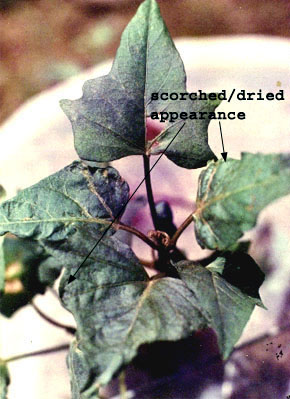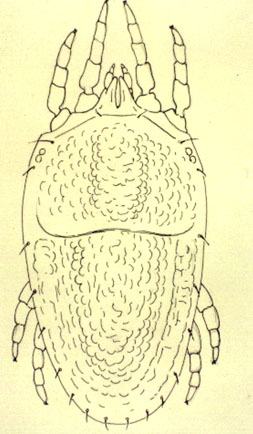|
|
Class |
Arachnida |
|
Order |
Acarina |
|
Family |
Tenuipalpidae |
The
false spider mite is an important acarine
pest of sweetpotato. It attacks many species other
than sweetpotato. High infestation occurs during the dry season.
Worldwide.
The mites suck the
sap from the petiole and leaves causing the leaves to become
deformed, with a rough, thickened and shrivelled appearance. The back of
the leaf may appear scorched (turn yellowish
brown) and dotted with inconspicuous whitish feeding punctures.
During heavy infestation stunting occurs.
Egg
The egg is smooth, plain and elliptical. Newly laid eggs are shiny bright
orange.
Larva
The newly-hatched larva is bright red-orange and ovoid. It can be identified
through its three pairs of short stout legs, the first two pairs positioned
anteriorly.
Protonymph
The protonymph has four pairs of legs and the body is ovoid. It is three
times bigger than the larva and its appendages are more slender, tapering and
colourless. A prominent dark reddish area appears on the dorsum while the rest
of the body becomes almost colourless as it grows.
Deutonymph
The deutonymph is similar to the protonymph but bigger and more slender.
Adult
The adult is similar to the
deutonymph but bigger and the dorsal spots are brighter. The legs and chelicerae
are distinct.
The preoviposition period lasts one to two days. The adult female can lay an
average of 43 eggs in 20 days. Mated females lay eggs for both sexes whereas the
unmated ones produce only male eggs. Incubation period is 3 days. Egg
hatchability is 97%. The mite undergoes three moults which lasts 2-5 days
between each moult. The total developmental period (egg to adult) is about two
weeks. The male to female ratio of the progenies of the mated females is
1.0:2.82. Adult males have shorter life span (18 days) than females (21 days).
This species feeds on a wide variety of plants including many crops and
ornamentals. Pritchard and Baker (1958) listed 43 host species known from all
over the world. Important crops and weeds apart from sweetpotato as alternate
hosts include the following: Ipomoea spp. such as I. purpurea, I. triloba, I.
aquatica, I. pes-caprae, Moringa oleifera, Solanum melonena, Glycine max,
Cucurbita maxima, Lycopersicon esculentum, Manihot esculenta, Vigna
sesquipedalis, Hibiscus esculenta, Ceiba pentandra, Carica papaya, Averrhoa
carambola, citrus mitis, Citrus nobilis, Cocos nucifera, Commelina diffusa,
Leucaena leucocephala, Ricinus communis, Stachytapheta jamaicensis, Passiflora
edulis, Terminalia citrina, Costus speciosus, Acalypha spp, Capsicum
frutescence, Desmodium gangeticum, Gmelina arborreaIxora longistipula, Manihot
multiglandusa, Wedelia biflora and many more.
Several species of coccinellid beetles, and phytoseiid mites [Amblysieus
linearis Corpus and Amblysieus longispinosus (Evans)] prey on all
stages of development.
Chemical control
Several insecticides and acaricides are available for mite control.
Amalin, D.M. and E. A. Vasquez. 1993. A handbook on Philippine sweetpotato
pests and their natural enemies. International Potato Center (CIP), Los Baņos,
Philippines. 82 p.
Gapud, V.P. and L.C. Raros. 1986. Guide to Philippine Flora and Fauna - Water
Bugs and Mites. Vol. VII. Natural Resources Management Center , Ministry of
Natural Resources and University of the Philippines. 204 p.
Jularbal, C.L. 1981. Biology of sweetpotato false spider mite, Brevipalpus
californicus Banks (Tenuipalpidae, Acarina). Unpublished BSA Thesis, Visayas
State College of Agriculture, Baybay, Leyte, Philippines.
Prtichard, A.E. and E.W. Baker, 1958. The false spider mite (Acarina:Tenuipalpidae).
Univ. Calif. Publ. Eent. 14(3): 175-274.
Vasquez, E.A. and
C.E. Sajise. 1990. Pests of sweetpotato: Insects, mites and diseases. Philippine
Root Crop Information Service, Philippine Root Crop Research &
Training Center. 65 p.
Contributed by: Erlinda
Vasquez and
Vilma Amante |
Taxonomy
Economic
importance
Geographical
distribution
Damage
Morphology
Biology
and Ecology
Host
Range
Management
References

Leaves
dry up when attacked by false spider mite (E. A. Vasquez).

Adult false spider mite (D. Amalin). |

